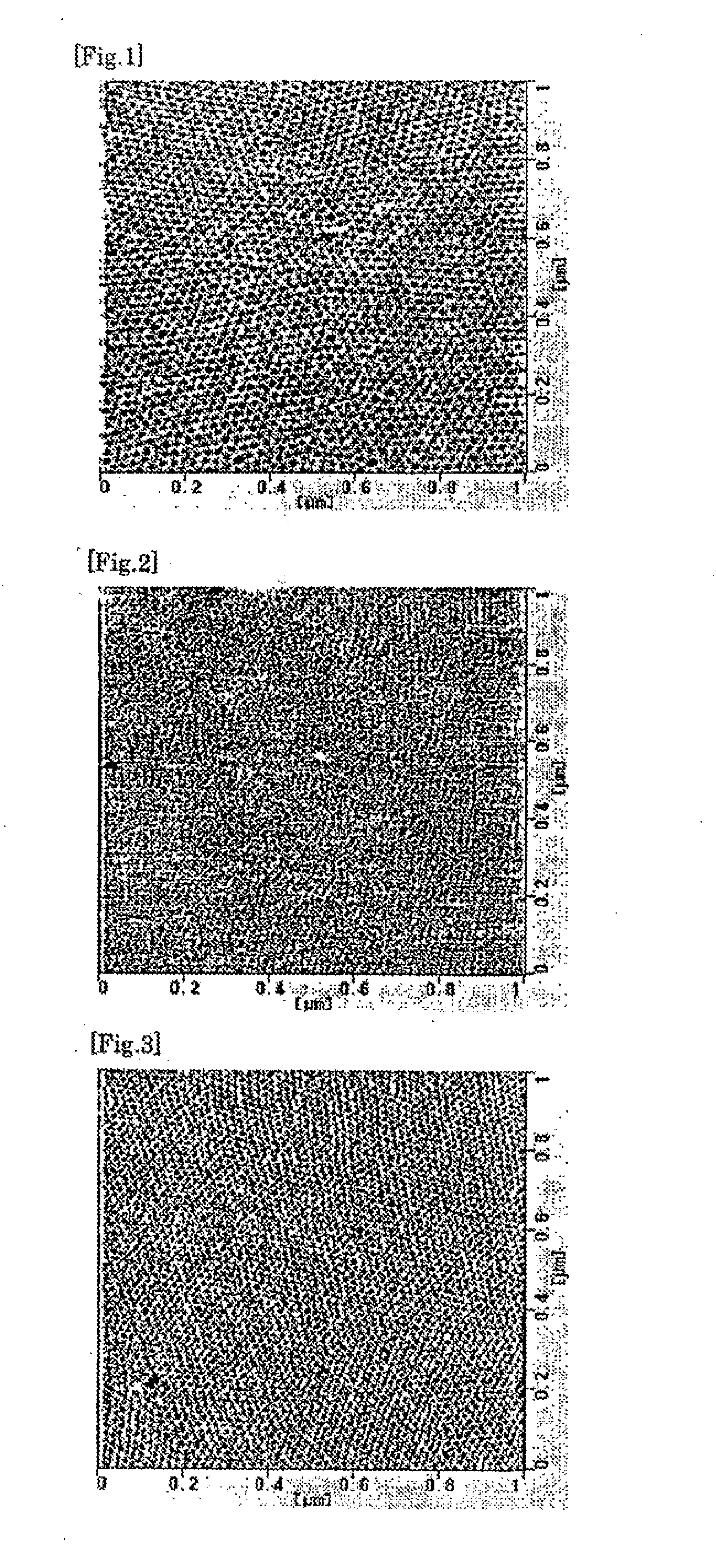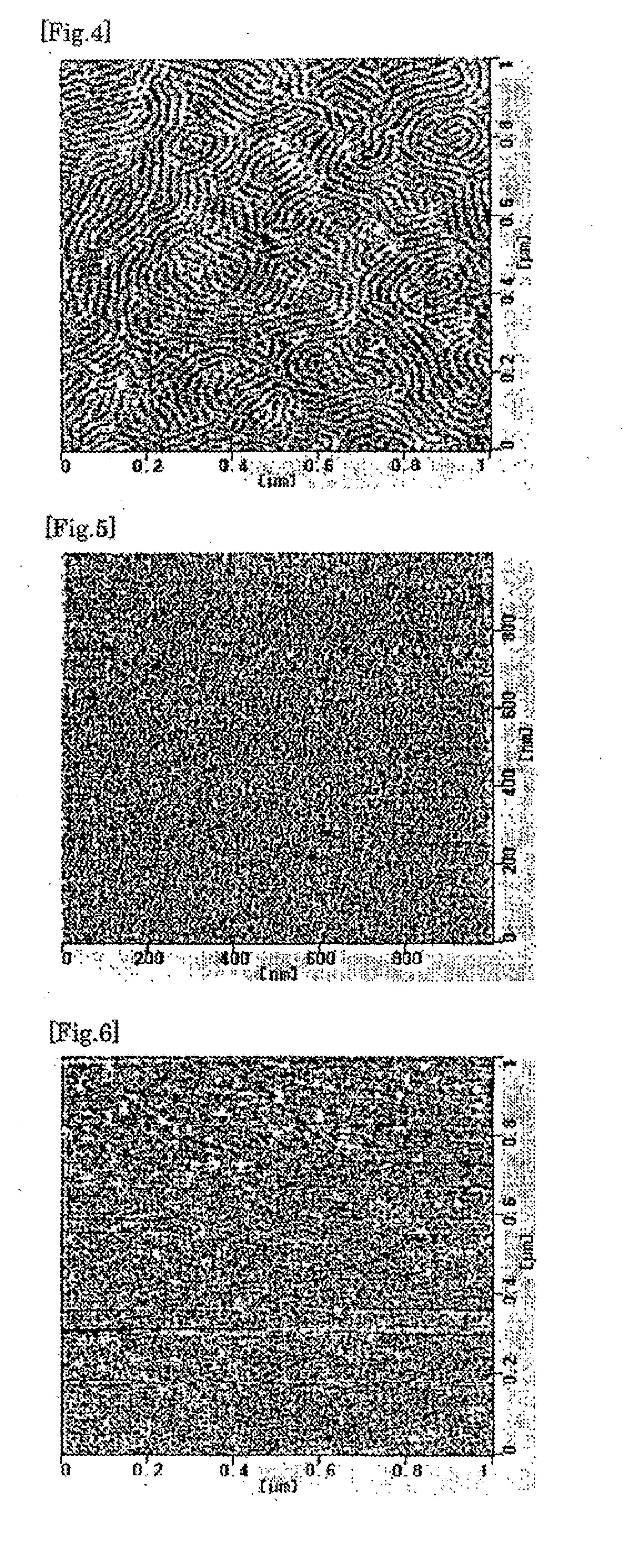Block copolymers
a technology of copolymer and block, applied in the field of block copolymer, can solve the problem of almost no microphase separation structure, and achieve the effect of reducing the number of microphases
- Summary
- Abstract
- Description
- Claims
- Application Information
AI Technical Summary
Benefits of technology
Problems solved by technology
Method used
Image
Examples
example 1
PSt / P (MA / MMA) Block Copolymer
[0113]Under nitrogen atmosphere, 1.07 g (2.57 mmol) of NBL was added to 454.8 g of THF supplemented with 1.92 g (1.72 mmol) of LiCl. The mixture was stirred for 30 min at room temperature, to remove water etc. in the system. After cooling the resultant to −40° C., 0.73 g (1.03 mmol) of DBuMg, 23.6 g (226.3 mmol) of St monomer were added. 0.7 g (1.68 mmol) of NBL was added to the resultant solution to initiate polymerization. After maturing for 10 min, 1.03 g (5.71 mmol) of DPE was added, and stirred for 10 min. Next, a mixture of 2.0 g (10.2 mmol) of ECHMA monomer, 4.43 g (44.2 mmol) of MMA monomer, and 0.44 g (0.59 mmol) of DEtZn was added and stirred further for 90 min. Methanol was added to this reaction solution to stop the reaction, and reprecipitation operation was performed with methanol solvent, and filtrated. By air-drying the obtained filtrate, a PSt / P (ECHMA / MMA) block copolymer was obtained (Mw=28400, Mw / Mn=1.12, St / ECHMA / MMA=80 / 4 / 16 mol).
[0...
example 2
Pst / P (MA / MMA) Block Copolymer
[0116]PSt / P (MA / MMA) block copolymer B was obtained by a similar method as Example 1 (Mw=16400, Mw / Mn=1.12, St / MA / MMA=80 / 4 / 16 mol).
[0117]A sample with a film thickness of 37 nm was obtained by employing this polymer B by a similar method as Example 1, and was measured by a AFM phase mode. A clear sea-island shape phase separation structure with a diameter of about 7 nm was observed (FIG. 2).
example 3
Pst / P (HEMA / MMA) Block Copolymer
[0118]Under nitrogen atmosphere, 21.4 g (205.1 mmol) of St monomer was added into 40.3 g of THF and 164.2 g of toluene, and cooled to −40° C. Next, 1.09 g (2.73 mmol) of NBL was added and stirred for 30 min. Further, 1.74 g (9.65 mmol) of DPE was added and stirred for 10 min. Then, a mixture of 3.82 g (18.9 mmol) of SiOEMA monomer, 2.82 g (28.2 mmol) of MMA monomer, 3.32 g (2.98 mmol) of LiCl, 1.21 g (1.63 mmol) of DEtZn and 11.9 g of THF was added and stirred for 90 min. Methanol was added to this reaction solution to stop the reaction, and a reprecipitation operation was performed with a methanol solvent, and filtrated. By air-drying the obtained filtrate, PSt / P (SiOEMA / MMA) block copolymer was obtained (Mw=14900, Mw / Mn=1.09, St / SiOEMA / MMA=81 / 8 / 11 mol).
[0119]The obtained polymer was dissolved in THF to make a 10 wt % solution, and deprotection reaction was performed by employing hydrochloric acid at room temperature for 30 min. The reaction solution...
PUM
| Property | Measurement | Unit |
|---|---|---|
| domain size | aaaaa | aaaaa |
| glass transition temperature | aaaaa | aaaaa |
| domain size | aaaaa | aaaaa |
Abstract
Description
Claims
Application Information
 Login to View More
Login to View More - R&D
- Intellectual Property
- Life Sciences
- Materials
- Tech Scout
- Unparalleled Data Quality
- Higher Quality Content
- 60% Fewer Hallucinations
Browse by: Latest US Patents, China's latest patents, Technical Efficacy Thesaurus, Application Domain, Technology Topic, Popular Technical Reports.
© 2025 PatSnap. All rights reserved.Legal|Privacy policy|Modern Slavery Act Transparency Statement|Sitemap|About US| Contact US: help@patsnap.com



